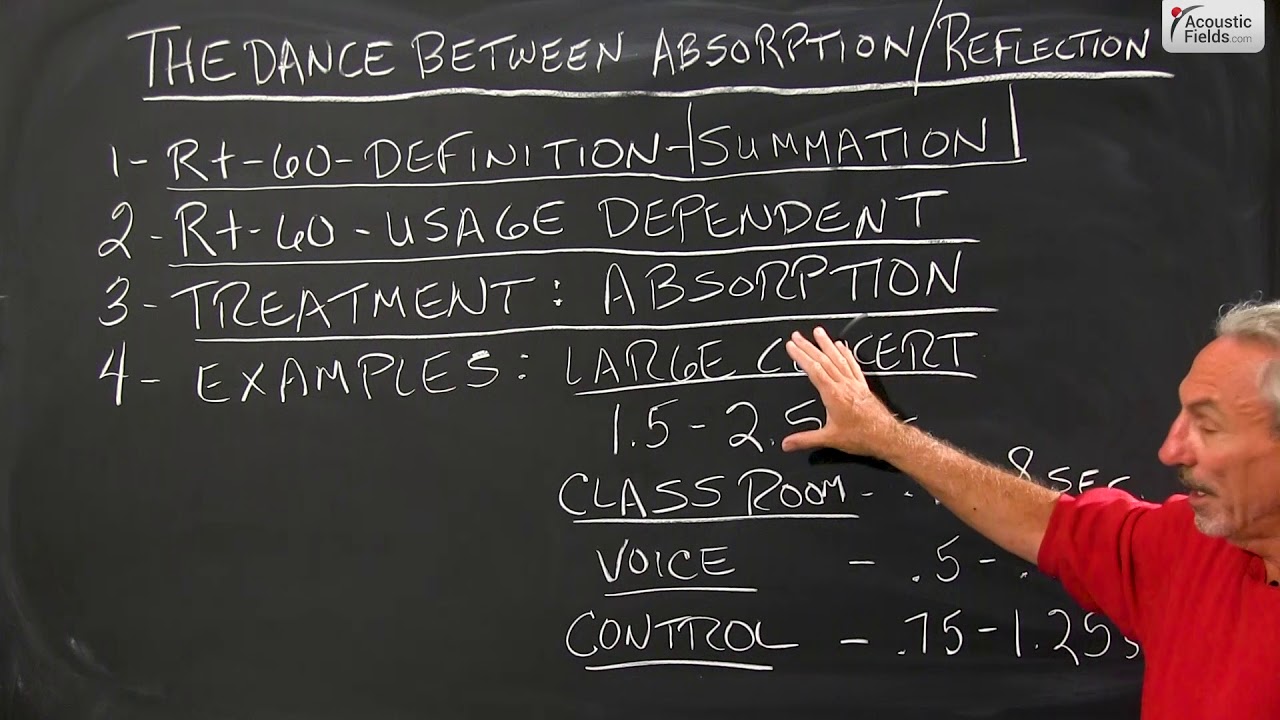Let’s talk about the dance between absorption and reflections. We all deal with reflections in our room, it doesn’t really matter what the room size and volume and usage is, it’s a room. It has boundary surfaces, the energy strikes these surfaces and causes a reflection.
So we know what RT-60 times are, we’ve heard this term many, many times. I want you to think about the RT-60 time as a summation of all the reflections in the room, their birth, their death so to speak and the life between those two points. So attack, decay, it’s all of this energy, subsistance of energy and the cycle keeps repeating itself. But it’s really a summation of all the reflections in the room.
Now, what we have to understand is that the RT-60 is just a measurement that we have to utilize to balance with our usage. So different usages, we have to control the amount of reflections in a different way. We have to lower them and sometimes we have to raise them. What is our treatment of choice? Almost in all the cases it’s absorption. Diffusion is our other option.
But let’s focus on absorption for now and look at some of the differences in RT-60 times that are in the literature. And I have scoured the literature, I have about a 100 books that give all kinds of data on past measurements of rooms and stuff. And I took about 20 of those and I synthesized these RT-60 times out of those books.
So let’s take a look at what they’re saying. In large concert venues: 1.5-2.5 seconds is kind of the range that designers and everybody shoots for. Class room: .4-.8 seconds RT-60 time. Big, big difference. Large venues here, smaller rooms here. The lower the RT-60 time the more emphasis on speech intelligibility. Because the lower the RT-60 time, the more definition we get. So we get to hear speech better, okay?
Voice: .5-.75 seconds. Real close to class room RT-60 times. And then control rooms: .75- 1.25 seconds on the average. Now, I’ve been in control rooms that are 0.5 of a second, I’ve been in control rooms that are three tenths of a second. But it all goes back to usage. If you look at all of these situations here, large concert hall, class room, voice, control… usage. What are you doing in the room? And once you decide what you’re doing in the room, and please don’t try to do too many things. Don’t try to do voice in a large concert hall. Don’t try to do voice in a control room which a lot of people try to do. Don’t try to do voice in a classroom. Because look, the RT-60 times are close but when you’re recording voice, the microphone is going to hear more than this numerical difference shows.
So usage is critical. These are some ranges of RT-60 times that I pulled out of the literature. Your usage, your RT-60 time may vary because it’s subjective. Everybody’s is a little bit different. But these are some guidelines and some ranges we can use.
—
This is an unedited transcript from our video series from Acoustic Fields. There will be some errors in grammar and sentence structure that occur during this translation process.
For complete understanding and comprehension, please view the video which is included in this text. For any additional information regarding this topic or others relating to room acoustics, please contact us directly at:
P: 520 – 392 – 9486







